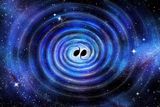Recent observations have confirmed that colliding black holes emit a significant, ringing energy, supporting the theories of renowned physicists Albert Einstein and Stephen Hawking. According to Max Isi, an astronomer at Columbia University and the Simons Foundation, the collision of these cosmic giants can convert the mass equivalent of three suns into energy in a mere fifth of a second, making it the most powerful event in the universe.
The groundbreaking findings were made possible through the efforts of the Laser Interferometer Gravitational-wave Observatory (LIGO), which consists of two facilities located in Washington state and Louisiana. These sites are strategically placed in remote areas to minimize environmental noise. LIGO operates by directing lasers toward a beam splitter, which redirects the beams into L-shaped pathways. The mirrors positioned 2.5 miles (4 kilometers) apart allow scientists to detect gravitational waves. When such waves pass through, they momentarily alter the lengths of the beams, producing detectable signals.
The initial detection of a ringing signal from colliding black holes occurred in 2015. Since then, the frequency of these detections has dramatically increased, with LIGO scientists now observing events almost daily. On January 14, 2025, researchers captured the clearest signal yet from a collision approximately one billion light-years away. A study detailing these findings has been published in the journal Physical Review Letters, involving nearly 1,000 contributors from LIGO, as well as the Kamioka Gravitational Wave Detector (KAGRA) in Japan and the Virgo interferometer in Italy.
Understanding the Gravitational Waves
Black holes generate immense energy, and their collisions distort the surrounding space-time, creating ripples akin to the sound produced by a ringing bell. These gravitational waves carry specific characteristics that scientists have learned to interpret. Just as the pitch and duration of sound waves can reveal the size of a bell, gravitational waves provide insights into the properties of their sources.
According to Roy Kerr, a physicist who contributed to black hole theory, these objects can be accurately described solely by their mass and spin. The analysis of gravitational waves from these collisions has offered compelling evidence supporting this notion. Researchers have successfully identified the two black holes involved in the January 2025 collision, along with the resultant larger black hole. This entire process unfolds in approximately a fifth of a second, followed by a ringing that persists for about ten milliseconds.
Confirming Theories of Einstein and Hawking
While Einstein did not directly predict black holes, his general theory of relativity laid the groundwork for their eventual identification. Hawking’s theories suggested that black holes could only increase in size, which relates to the area inside their event horizons—the boundary beyond which no light can escape. Hawking believed that the detection of black hole mergers would eventually offer proof of his theories, a vision he did not live to see, as he passed away in 2018.
With improved measurement techniques, the collision on January 14, 2025, provided definitive confirmation of Hawking’s area law. The two colliding black holes each had a mass equivalent to about 33 suns. Upon merging, they formed a new black hole with a mass of approximately 63 suns, losing around three suns’ worth of mass as energy in the process.
This phenomenon illustrates the relationship between Hawking’s area law and the second law of thermodynamics, which states that entropy—essentially disorder—tends to increase. Isi noted that in the context of black holes, the area within the event horizon can be viewed as a measure of this disorder, further intertwining these significant scientific principles.
These findings not only validate longstanding theories but also open new avenues for understanding black holes and their fundamental properties, marking a significant milestone in modern astrophysics.







